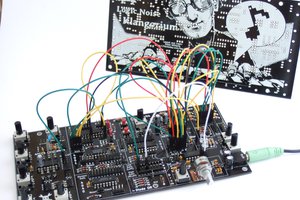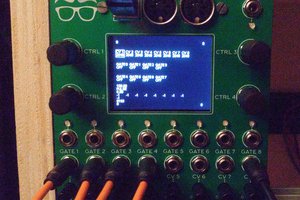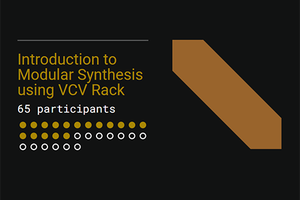ABOUT THE CIRCUITS
I know very little about how these circuits actually work– 99% of the circuits come from the internet, especially the following places:
– electro-music.com DIY forum
– electro-music.com Lunetta forum
– Nicholas Collins’ “Handmade Electronic Music” (2006)
– Fun with Seamoss website (no longer up)
– Hackaday Logic Noise series
– Ken Stone’s Modular Synth site
– Yu Synth DIY
Thanks to all those folks for sharing their designs! Please don’t look at my circuits, go see the originals. Those folks know what they are doing. My circuits are only here for reference, just to show you can build a great-sounding synthesizer with extremely primitive circuits.
BUILDING THESE CIRCUITS
Don’t just build these circuits– breadboard them first! I made many small modifications that may not be reflected in the schematics; also, I barely understand anything about electricity so take everything with a grain of salt. If you know your way around electrical engineering you will probably see about a million things I’ve done incorrectly. That said, my synthesizer works and sounds awesome, and I haven’t blown anything up (except for a handful of ICs, resistors, LEDs, pots, transistors, and other components).
MY SYNTH “FORMAT” AND CONSTRUCTION
Originally I intended to follow the Eurorack format (which I think is ±12V with +5V for digital modules) but I’m not skilled enough (nor did I have the right wall warts) for that. Instead, my synth uses ±9V (from a +20V wall wart) and +5V (from a +6V wall wart). The size is mostly Eurorack (3U tall) and I’ve built my cases standard rack size widths (19″). My panels are constructed out of 1/8″ plywood, mostly oak, and decorated with sharpie markers. For connectors I use #6 nuts and bolts and connect them with alligator clip patch cables I make using clips and boat trailer wire I get at the grocery store (comes in cool colors). My general focus has been on building basic modules that can be patched to make cool sounds. I also use a lot of LEDs because blinkenlights are awesome.
I currently (Feb 2016) have about 45 modules that include around 15 oscillators (mostly square waves) and lots of ways to manipulate them (filters, logic modules, shift register, sequencer, comparator, dividers, envelopes, LFOs, amps, etc). I also have a sort of “skiff” that includes a very primitive keyboard and a breadboard mounted into a panel for easy circuit building. My synth is built into 4 19″ x 6U cases (24U of modules) constructed out of wood from reclaimed pallets.
In addition to the DIY modules, there is also a broken-down Korg Monotron Duo I use primarily for the excellent low pass filter and a Korg Volca Keys I separated from its case and shoved into my rack.
MORE INFO
Circuits, code, panel design, PureData patches, Arduino sketches, etc: https://github.com/chrisbeckstrom/diy_modular_synthesizer/
Hackaday IO project: https://hackaday.io/project/5826-diy-mostly-analog-modular-synthesizer
LIST OF MODULES
updated February 20, 2016
OSCILLATORS/GENERATORS
--- AUDIO RATE
VCO (saw, square, triangle, short pulse)
VCO (saw, pulse)
voltage controlled digital sound source (arduino) with MIDI input
-- LFOs
Dual LFO (square, triangle)
square LFO ("pulse")
LFO (not working)
LFO x3 (square, "triple clock")
LFO x5 (square LFOs)
-- OTHER
CMOS noise
White noise (HP, LP, regular)
MODULATION
--- VCAs
VCA (op amp + transistor, diode)
VCA (transistor)
low pass gate VCA/filter
dual VCA (vactrols)
VCA (vactrol)
--- SEQUENCING
10 step sequencer (CV and gate)
dual 4-stage shift register
--- ENVELOPES
envelope generator (A/D)
slope generator (rise/fall)
--- CONTROLLERS
shotgun shell photoresistor
expression pedal input
arbitrary voltage controller (keyboard-type thing with gate and CV outputs)
ribbon controller
--- OTHER
sample and hold
HARMONICS/WAVESHAPING
low pass resonant filter, voltage controlled
voltage controlled filters low pass + high pass (can combine for band pass)
twin T drum/filter (not working)
voltage controlled diode clipper (positive...
Read more » chrisbeckstrom
chrisbeckstrom After a few months focused on other things (fishing, cooking, kayaking, etc) I'm back on the synthesizer building war path."In the past few weeks I filled my third 19" x 6U rack and built another. Some of the new modules:
After a few months focused on other things (fishing, cooking, kayaking, etc) I'm back on the synthesizer building war path."In the past few weeks I filled my third 19" x 6U rack and built another. Some of the new modules:




 Elliot Williams
Elliot Williams
 Steven Gann
Steven Gann
 Michele Perla
Michele Perla
 Lutetium
Lutetium
Very sweat build. I would be tempted to try something like this but my current project says no :-)